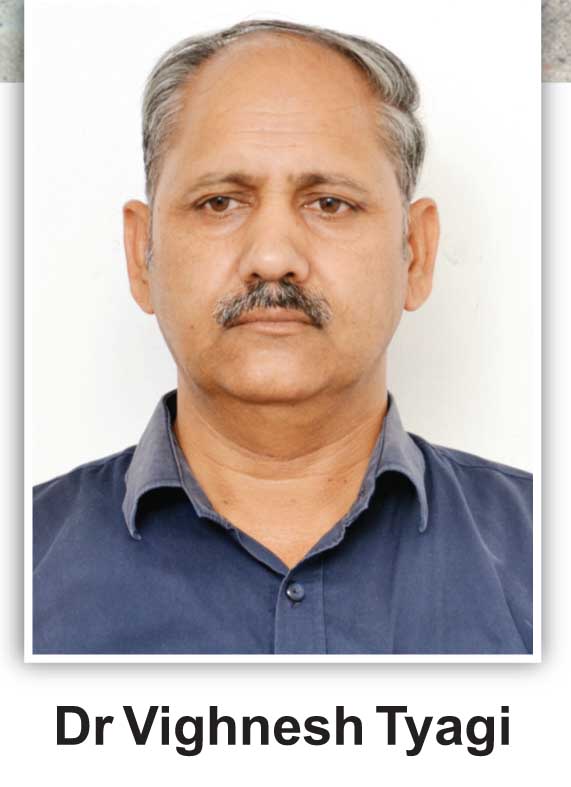Ajay Mittal from Meerut
 Searching and preserving ancient artifacts representing our rich cultural heritage, exhorting people to do that, waging a relentless war through writings and other means against the Left bent upon decimating Hinduism and its
Searching and preserving ancient artifacts representing our rich cultural heritage, exhorting people to do that, waging a relentless war through writings and other means against the Left bent upon decimating Hinduism and its
manifestations—all this comes to him naturally. Born and brought up in an atmosphere in which he memorised the Brahmcharya Sookt of Atharva Veda and Vishay Ninda chapter of Adi Shankaracharya’s Vivekchudamani at a tender age of 8, he certainly deserves to be called a
cultural soldier par excellence. He heads the Department of History at Meerut College, Meerut, one of the prestigious institutions of the city. He is also the Kshetra (regional encompassing Uttarakhand, Meerut and Brij Prant in RSS parlance) organising secretary of Akhil Bharatiya Itihas Sankalan Yojna, the premier organisation engaged in reclaiming Bharatiya history. Dr Vighnesh Tyagi has a record of three decades of work that speaks for itself.
Dr Vignesh Tyagi has been a tireless soldier working to identify, excavate and protect a number of important monuments related to ancient, medieval and modern periods of Indian history in the Ganga- Ramganga Doab region. He has been successful in getting many monuments excavated. Foundation of Hastinapur Shodh Sansthan 22 years ago to carry out the work more effectively was an important step in this direction
Nailing the Lies
Dr Tyagi’s subject is history. He has written a number of books nailing the lies of the Left propagandists masquerading as historians with official patronage for long. But his innate interest in archaeology would surprise anyone. He discovered the Harappan site Sinauli Sadiqpur in Baghpat district of Uttar Prades in 2004. He discovered a number of pieces of Ochre Coloured Pottery (OCP), Painted Grey-Wares (PGW) and early historic sites in UP. He discovered ostrich in pre-historic Indian rock paintings for the first time in the world in the Payagaa hills of the Arawali at Sohanpur in Sikar district of Rajasthan. He identified the original location of Ashokan pillar inscription taken from Meerut to Delhi by Feroz Shah Tughlaq. He has also identified a number of important monuments relating to ancient, medieval and modern periods of Indian history in the Ganga-Ramganga Doab region. He is a tireless
soldier working incessantly in this field. He has been successful to get protected these sites and excavated monument by approaching the powers that be. He founded the Hastinapur Shodh Sansthan to carry out the work more effectively 22 years ago. He was asked by former RSS stalwart Shri KS Sudarshan to assist Dr SP Gupta, the renowned archaeologist, during Shri Ram Janmabhoomi movement.
Siddh Temple, Amroha
The most fascinating story about Dr Tyagi’s struggle to preserve ancient Hindu monument as they were relates to the Siddh or Sadhu Mandir of Amroha. Historian HR Nevill’s Gazetteer of Moradabad (1905) calls it Sadhu Temple. It was built by Ambika Devi, a sister of Prithvi Raj Chauhan during 12th century. But during 15th century, a Shia religious cleric Sheikh Saddo made it a place of his preaching. Shias of the area around it, mostly converted Hindus, began calling it ‘Sheikh Saddo ki Khankah’. But it retained its temple features even thereafter. Earthen lamps were lit here everyday. Water was offered on Shivpindi. Bells were rung morning and evening. Hindus offered their hair outside and then bathed in a sacred well. The chadava went mostly to Shia clerics and some was kept for Hindu pujari as also maintenance of the temple.
In 1966, the Sunnis laid claim over it. Two cases were filed. One by the Sunnis in Allahabad High Court and the other by the Shias in the Lucknow bench of High court. Dr Tyagi supported the Shias. In a way it turned out to be a legal battle between the Hindu-Shia combine against the Sunnis. On May 19, 2017, the High Court rejected the Sunni prayer and ordered the SDM of Amroha to expeditiously investigate and settle the case. Munavvar, the Shia owner of the Khankah, gave away two excellent sculptures of gods/godesses to Dr Tyagi. These were found in a mini excavation inside the temple premises. According to him, there are a number of such pieces of historical and archaeological importance buried inside. Munavvar says that the place is unquestionably an ancient Mandir. n













Comments